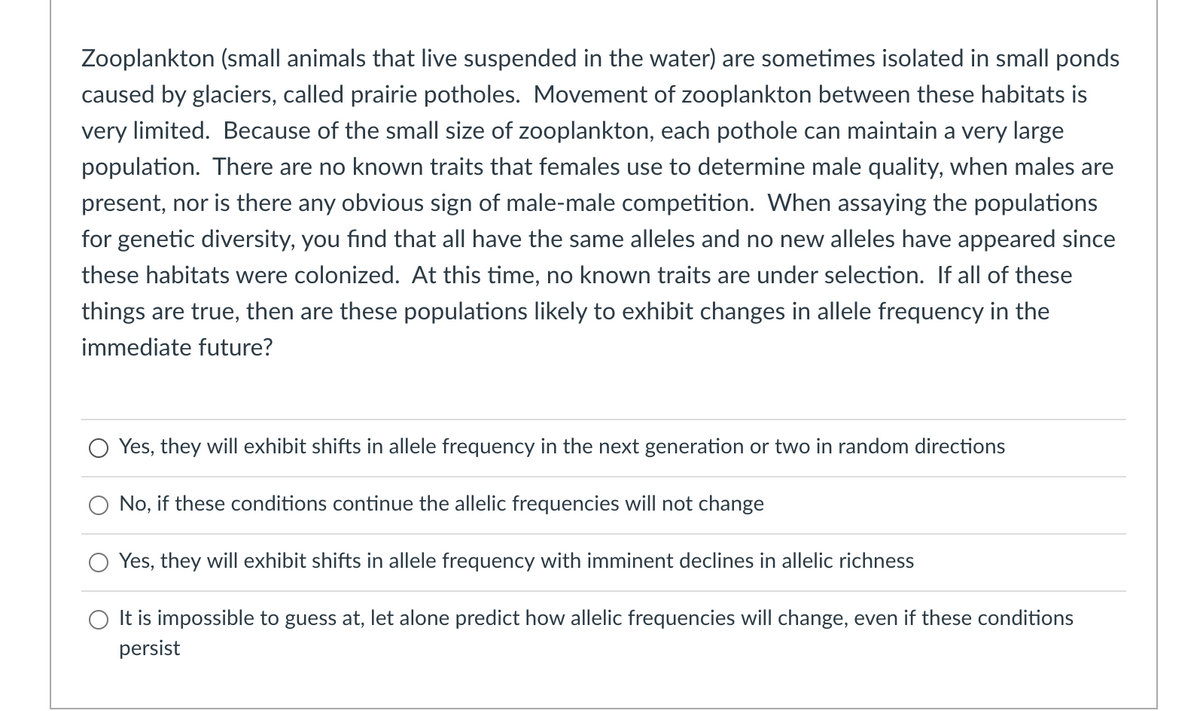Zooplankton (small animals that live suspended in the water) are sometimes isolated in small ponds caused by glaciers, called prairie potholes. Movement of zooplankton between these habitats is very limited. Because of the small size of zooplankton, each pothole can maintain a very large population. There are no known traits that females use to determine male quality, when males are present, nor is there any obvious sign of male-male competition. When assaying the populations for genetic diversity, you find that all have the same alleles and no new alleles have appeared since these habitats were colonized. At this time, no known traits are under selection. If all of these things are true, then are these populations likely to exhibit changes in allele frequency in the immediate future? Yes, they will exhibit shifts in allele frequency in the next generation or two in random directions No, if these conditions continue the allelic frequencies will not change Yes, they will exhibit shifts in allele frequency with imminent declines in allelic richness O It is impossible to guess at, let alone predict how allelic frequencies will change, even if these conditions persist
Zooplankton (small animals that live suspended in the water) are sometimes isolated in small ponds caused by glaciers, called prairie potholes. Movement of zooplankton between these habitats is very limited. Because of the small size of zooplankton, each pothole can maintain a very large population. There are no known traits that females use to determine male quality, when males are present, nor is there any obvious sign of male-male competition. When assaying the populations for genetic diversity, you find that all have the same alleles and no new alleles have appeared since these habitats were colonized. At this time, no known traits are under selection. If all of these things are true, then are these populations likely to exhibit changes in allele frequency in the immediate future? Yes, they will exhibit shifts in allele frequency in the next generation or two in random directions No, if these conditions continue the allelic frequencies will not change Yes, they will exhibit shifts in allele frequency with imminent declines in allelic richness O It is impossible to guess at, let alone predict how allelic frequencies will change, even if these conditions persist
Biology: The Unity and Diversity of Life (MindTap Course List)
14th Edition
ISBN:9781305073951
Author:Cecie Starr, Ralph Taggart, Christine Evers, Lisa Starr
Publisher:Cecie Starr, Ralph Taggart, Christine Evers, Lisa Starr
Chapter43: Animal Behavior
Section: Chapter Questions
Problem 2CT
Related questions
Question

Transcribed Image Text:Zooplankton (small animals that live suspended in the water) are sometimes isolated in small ponds
caused by glaciers, called prairie potholes. Movement of zooplankton between these habitats is
very limited. Because of the small size of zooplankton, each pothole can maintain a very large
population. There are no known traits that females use to determine male quality, when males are
present, nor is there any obvious sign of male-male competition. When assaying the populations
for genetic diversity, you find that all have the same alleles and no new alleles have appeared since
these habitats were colonized. At this time, no known traits are under selection. If all of these
things are true, then are these populations likely to exhibit changes in allele frequency in the
immediate future?
O Yes, they will exhibit shifts in allele frequency in the next generation or two in random directions
No, if these conditions continue the allelic frequencies will not change
Yes, they will exhibit shifts in allele frequency with imminent declines in allelic richness
O It is impossible to guess at, let alone predict how allelic frequencies will change, even if these conditions
persist
Expert Solution
This question has been solved!
Explore an expertly crafted, step-by-step solution for a thorough understanding of key concepts.
Step by step
Solved in 3 steps

Knowledge Booster
Learn more about
Need a deep-dive on the concept behind this application? Look no further. Learn more about this topic, biology and related others by exploring similar questions and additional content below.Recommended textbooks for you

Biology: The Unity and Diversity of Life (MindTap…
Biology
ISBN:
9781305073951
Author:
Cecie Starr, Ralph Taggart, Christine Evers, Lisa Starr
Publisher:
Cengage Learning

Biology: The Unity and Diversity of Life (MindTap…
Biology
ISBN:
9781305073951
Author:
Cecie Starr, Ralph Taggart, Christine Evers, Lisa Starr
Publisher:
Cengage Learning